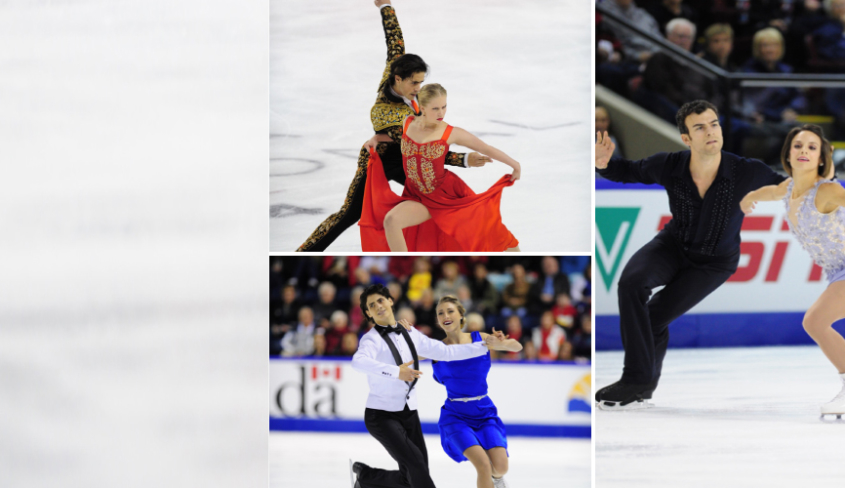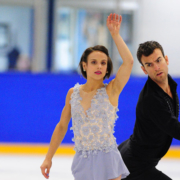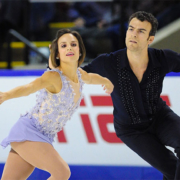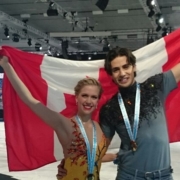Next stop Barcelona
Canada’s teamsters are the power base of the six-member team that qualified for the Grand Prix Final in Barcelona next week. This year, they are dancing and throwing and lifting like nobody’s business.
For Canada, without any Elvis Stojkos, or Joannie Rochettes, or Jeff Buttles, or (even any Emanuel Sandhus) this time, the men and women singles skaters of the country are sitting it out, while the pairs and dance teams go to battle. They are powerful. They have proven to be winners.
In fact, Canada’s pair champions Meagan Duhamel and Eric Radford and its heart-grabbing dance doublet, Kaitlyn Weaver and Andrew Poje have had similar trips to get to the Grand Prix Final this season, having decisively won both of their grand prix events this year. “We are one team,” said the caption under one photo of them together at the end of the NHK Trophy.
Their records are eerily similar. Both Duhamel and Radford and Weaver and Poje have had one fourth and two fifths in three previous appearances at the Grand Prix Final. But this is a different era and a different time. They have both come into their own.
“The biggest difference this year is that we didn’t squeak into the final like the last two years,” Duhamel said. “It’s kind of exciting for us.”
Also accompanying them are dancers Piper Gilles and Paul Poirier, who are getting to the final for the first time in their careers, although Poirier earned a bronze medal in 2011 with previous partner Vanessa Crone.
In the past, Canada’s men and ice dancers have proven most prolific at winning medals in the Grand Prix Final. Not so much the pairs team, although Canada has had a long history of successful pairs. Canada hasn’t won a Grand Prix Final pair medal of any colour since Jamie Salé and David Pelletier scored back-to-back wins in 2001 and 2002, enroute to winning an Olympic gold medal. That’s 12 years ago.
But Duhamel and Radford are sliding to the Grand Prix Final with a new trick (throw quad Salchow) and new attitudes. “We don’t have any fear when we are skating anymore,” Duhamel said. “Last year I was always scared to lose. Scared if another Canadian team was higher than us. Now we’re in control.”
“We just put too much pressure on ourselves,” Radford said. “We put so much energy on everybody else, rather than just concentrating on ourselves.” This year, with the Olympics in the past, they’ve let it all go. Now they aim to do the best they can and enjoy the ride, skate with freedom, challenge themselves with this new, rare trick, the throw quad Salchow.
They’ve wanted to do the quad since they hitched up together. Coach Richard Gauthier didn’t want them to take the risk. He told them they needed to do clean programs with the triples before they even thought about that quad – and to forget about it until after the Olympics.
During their tour with the Stars on Ice in the spring, that quad came back to mind. Before they went on vacation after the tour, they tried one – and Duhamel rotated it, although she fell.
“Okay, this is going to be possible,” Radford thought.
Their goal was to perfect this rare trick by the world championships in Shanghai, China in March. So far they’ve tried the throw four times in competition and landed it well twice. They missed it at the NHK Trophy in Japan, but adrenalin got the best of them. The lesson learned, Duhamel said, was to not make the thing so BIG.
After winning their first grand prix gold at Skate Canada International, Duhamel felt pressure to land the quad at the next one, and their focus switched away from their plan. They’ve now righted the course. As they did earlier in the year, they will now stay calm, let it happen.
As for Weaver and Poje, they’ve had “a grand season so far,” Weaver said. “We’ve competed in every competition with confidence and strength, and that in turn turned into winning scores.”
The best news is that they have lots of room to grow. At both Skate Canada International and NHK Trophy, they left marks on the table in some elements, but they’ve been working on all the little pieces of the puzzle to emerge “better and stronger and bigger” at the Final, Weaver said. They’re also adding more detail to their programs, particularly the challenging free dance, with all of its constant changes of positions and holds. “It’s a new year and a new quadrennial and we’re happy to be at the forefront of it,” Weaver said. “And hoping to continue Canada’s great tradition of dominance in ice dance.”
Canada has won 10 Grand Prix Final medals in ice dancing, but the last gold medal came from Shae-Lynn Bourne and Victor Kraatz in 2002 in the lead-up to the Salt Lake City Olympics. Now Bourne has had a big hand in their free dance and is a guiding voice on their road to success.
After a disappointing season last year, after missing the Olympics because of a severe leg fracture for Poirier, Canada’s other dance team finds their season going exactly to plan. The twosome set lofty goals for themselves this year and they are attaining them: winning medals at grand prix events and qualifying for the final.
Their troubled season changed their perspective, showed them they could improve quickly and already they are much further ahead than they were by the world championships last season. Poirier’s right leg is still weak, and he has limited range of motion in the ankle, but he can train at full capacity and the injury doesn’t limit him. They’re gratified that they were able to edge past Americans Madison Hubbell and Zach Donohue this season, when last year they were neck and neck with them.
Duhamel and Radford, the elder statesmen of the group at ages 28 and 29, are grateful they did not stop skating after last season. “We are wiser than we were last season,” Duhamel said. “I’m so happy I didn’t decide to quit last year. I would never know what it feels like to skate with freedom.”







Leave a Reply
Want to join the discussion?Feel free to contribute!